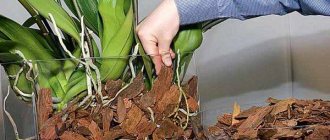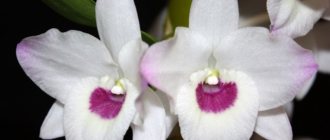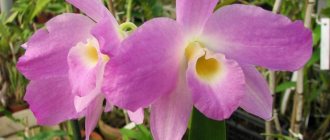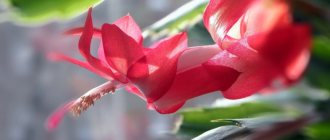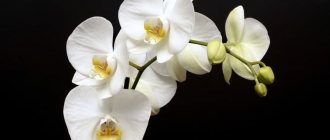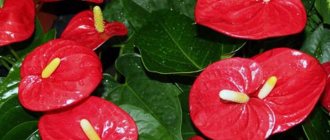3
(2)
Dendrobiums are a genus of sympodial orchids with a characteristic structure and very spectacular flowering. The two most common species in culture are dendrobium nobilis (nobile) and dendrobium phalaenopsis (so-called dendrophalus). Normally, these plants bloom profusely at any time of the year. But sometimes there are longer breaks between flowerings than necessary, or children are actively forming on plants instead of flower stalks. The proposed material will tell you how to make dendrobiums bloom.
Annual development cycle
To organize proper care for Dendrobium Nobile at home, it is necessary to distinguish between periods in the annual development cycle of orchids of this species.
The development cycle can be divided into 4 periods:
Growing season
In the spring-summer period (from March–April, including June), the plants wake up and vegetative development begins. At the base of the pseudobulbs, babies form, stems and leaves grow.
The impetus for the development of new shoots occurs only under certain lighting conditions.
If it is favorable throughout the year (i.e. 12 months in a row), then new shoots can appear constantly, making the plants more luxuriant.
The period of growth of new pseudobulbs and young roots
In May and until September, the development of the above-ground mass is accompanied by the active growth of old and the formation of young roots.
During the development of new shoots, it is advisable to keep the orchid sunny and warm, and after formation - sunny but cool. In such conditions, the orchid will quickly and well grow green mass and bloom faster.
As it develops, the new shoot elongates and swells, ultimately forming a new pseudobulb.
As soon as the new sprout is rounded and produces its last leaf at the top (“stop leaf”), it is considered mature, i.e. passed from the “new sprout” state to the “young pseudobulb” state.
Rest period
In September, the growth of shoots and the formation of pseudobulbs ends. Flower buds are being laid. From October there begins a dormant period, which (depending on the variety) lasts until January-February.
The most difficult thing in caring for the hybrid Dendrobium Nobile is the dormant period. Many different natural species that live in different climatic conditions take part in the formation of hybrids of this group.
In one area, the sun shines all year round and there is heavy rainfall, while in another, the year is clearly divided into a period of rain and a period of drought. Hence the different behavior of plants.
Under the conditions of an ordinary windowsill, the light intensity in winter drops so low that the metabolism inside the orchid is inhibited, and it can neither grow nor bloom.
About the same thing will happen to her as to our trees outside the window, when they shed their leaves and “fall asleep” until spring.
This condition is unnatural for an orchid. This can be avoided by installing artificial light lamps over the plants in the winter.
Flowering period
The appearance of flower buds marks the transition from dormancy to flowering. The main time for orchid flowering is in the winter from January-February to May.
To enjoy your orchid blooming longer, you need to keep it in a cool place where it is dry and away from direct sunlight.
Expert opinion on the use of cytokinin paste
To stimulate orchid flowering, many gardeners are experimenting with hormonal agents such as cytokinin paste. Unfortunately, such experiments do not always end successfully:
“It is impossible to accurately predict how cytokinin paste will affect an orchid. There are many cases of plant death after using this product. I don’t keep cytokinin paste in my orchidarium, but I always have flowering plants. I believe that such strong hormones do more harm than good. If an orchid does not bloom due to poor conditions or general weakness, pulling the latter from it is not only stupid, but also practically criminal.”
E. Samoilova, orchid collector with 10 years of experience
Temperature
Temperature affects all processes occurring inside the orchid indirectly, and more importantly, it is lighting.
It is lighting that causes the orchid to grow new roots, peduncles or leaves. Temperature can either speed up this process several times or significantly slow it down.
As soon as the light-temperature ratio is established at a favorable level, the orchid will grow literally before our eyes.
Pay attention to the changes in Dendrobium Nobile. Only through observation can you create optimal conditions for orchids.
If the temperature remains favorable and the light decreases significantly, then growth may stop. This happens in winter: the radiators are heated, and the sun hardly shines through the window, as a result the orchid sits motionless until spring.
In view of the diversity of hybrid orchids included in the Dendrobium Nobile group, the temperature regime can be described based on the behavior of the majority.
Summer: no higher than + 30 °C. Winter: 10-18 °C.
Lighting
The Dendrobium Nobile orchid is a light-loving orchid, but within the group itself, light preferences are heterogeneous.
You can buy two hybrids of different colors, place them on one window, and one will produce 2-3 generations of new shoots throughout the year, and the other will slowly but surely develop the only one that appeared in May-June.
Different genes are dominant in different hybrids. White and pale pink contain less light-loving natural orchids, while rich red or yellow ones contain more light-loving ones.
Southern, southwestern and western windows are suitable for any representatives of Dendrobium Nobile, but for the rest you will need to determine their suitability experimentally.
If, after moving the orchid to another place, the newly formed pseudobulbs are shorter than the previous ones, then this is an indicator of an excess of light.
Long and thin pseudobulbs (compared to the store-bought version, which was thicker and shorter) obtained on an eastern or northern window indicate a lack of light.
If the orchid does not bloom within 18 months, then you need to look for another place for it or install artificial light lamps in addition to regular lighting.
In the summer, it is advisable to take Dendrobium Nobile into the garden, onto the balcony, loggia. Or ensure excellent circulation of fresh air by ventilating the room as often as possible.
Remember! An important factor in creating optimal conditions is observing the orchid. An indicator of an optimal environment is the growth of green mass.
In our latitudes, the lighting in winter is very low; there is not enough light for the development of new shoots, so they appear in the spring.
They turn into a fully formed pseudobulb around October-November.
Transfer
There are two types of transplantation:
- planned - every 3-4 years, in a pot 2 cm wider than the previous one;
- emergency - immediately after purchase, if the flower is sick, pests appear or the substrate has deteriorated.
It is advisable to choose a pot for planting Dendrobium Nobile according to the size of the root system, so that the orchid fits freely into it and there is 2 cm of free space on the sides.
The pot should have drainage holes at the bottom and be opaque .
Planting in the middle fraction bark with moss, moss on top so that the rhizome does not dry out, you can add a handful of peat.
You can read about the composition of the substrate in the article Substrate for orchids.
Transplantation process
- The orchid is carefully removed from the pot, after soaking the roots and substrate with water.
- The old soil is completely removed from the orchid root system.
- Before transplanting, the roots of the orchid are carefully examined and rotten, damaged areas are removed. Leave it in the air for several hours so that the damaged areas dry out.
- Drainage from large pieces of bark is poured into the pot, and about a 2-3 cm layer of substrate is placed on top.
Since the rhizome of the orchid is small, the distance between the pseudobulbs is small, it is advisable to plant the orchid in the middle.
- The orchid is placed in the center of the pot, the remaining substrate is added to the sides. Pseudobulbs are not buried.
Care after flowering: what to do next?
After the dendrobium has bloomed, it must be prepared for dormancy. This requires:
- Stop feeding - the dendrobium does not need additional substances at this moment.
- Check the condition of the peduncle. It must be cut off, but it is completely removed only if it has dried entirely.
- Do not touch the plant. After flowering and pruning, orchids are very sensitive to changes in microclimate. It is not advisable to even move them to another place.
Read all the rules for caring for the plant in the general article.
Is pruning required?
You can trim the peduncle only after it has completely dried out. If only the tip has dried, step back 15 mm from the outermost dormant bud and cut off the dried part. The cut should be sealed with wax so that water does not get inside the stem and rotting does not begin.
If there are 1-2 unopened buds left on it, prune it early, the orchid may bloom again. In any case, you need to wait until the pseudobulb gives the plant all the water and accumulated substances.
If the peduncle continues to turn green and grow, it is not cut off. It is possible that buds will form and bloom again.
Read more about what soil to choose for dendrobium in the store and how to prepare it yourself here.
Top dressing
Feed during active development, once every 10 days. Do not fertilize during the dormant period.
You can feed only from April-May to September inclusive, when the orchid is in active growth (growing roots and leaves).
Important! You should not feed an orchid that is dormant or relatively dormant during the winter months; you should also not fertilize sick plants or newly transplanted ones.
The fertilizer used is a special mineral one for orchids. Use strictly according to the instructions, otherwise there will be no desired effect.
Dendrobium Pests
Quite often, these orchids are attacked by insect pests. These can be thrips, mealybugs, scale insects, whiteflies and aphids. The succulent leaves of the plant suffer first. If thrips attack, a silvery sheen appears on the leaves. They turn grayish-brown, wither, and fall off. You will notice the appearance of scale insects by brownish plaques on the surface of the leaves. The scale insect sucks the juices from the leaves, causing them to dry out and fall off. You will see traces of mealybug activity in the white coating on the back of the leaves. Leaves also suffer when they are infected with whiteflies and aphids.
At the first signs of the appearance of any parasite, we recommend that you first thoroughly wash off all insects from the Dendrobium with a warm shower in the bathroom, and then treat the bush with some insecticide, of which there are many in stores. Here are some names: actara, actellik, fitoverm. The choice is yours. Just carry out the treatment strictly according to the instructions. If repeated treatments are necessary at certain intervals, repeat them, since it is not realistic to destroy the entire population of parasites with their eggs and larvae at one time!
And for the future, don’t put it on the shelf next to orchids:
- bouquets of garden flowers;
- vases with vegetables and fruits;
- pots with newly acquired indoor flowers.
All of them can be carriers of the larvae of certain parasites.
Personal experience
I bought my first Dendrobium Nobile in December 2012. There was very little information, since most articles described the care and maintenance of phalaenopsis.
The main information was that Dendrobium Nobile is a difficult orchid to care for, that it should dry out between waterings, stop watering after the “stop leaf” appears and do not water it until flowering, and keep it in a cool place during the dormant period.
Nobile placed her Dendrobium in the southwest window. I watered by soaking, and determined the next watering by the pseudobulbs: if they shriveled, it was time to water. After the “stop leaf” appeared on the pseudobulb, watering was stopped until flowering.
The first home flowering was only three to four years after purchase. The reason was that there was only one pseudobulb when purchased. Dendrobium Nobile needed to grow green mass.
Important! When purchasing dendrobium, pay attention to the number of pseudobulbs, there should be at least three. If less, the plant is considered weak and may not survive.
In 2022, I decided to change my care: I didn’t dry it out during the growth period, but in the summer I took it out to the summer veranda and fed it. The pseudobulb has grown twice as much as last year.
New growth appeared in August. In past years, there was only one increase per year. Let's see how it blooms.
When does budding begin in children?
Propagation of dendrobium is often carried out with the help of children formed on the stem of the plant. Typically, the first flowering after transplantation occurs after one year. If this does not happen, you need to check whether all the conditions described above have been created for the plant.
Read more about caring for children after transplantation here.
